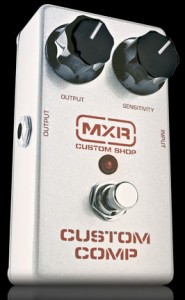Comp Lit, Pt. 4: MXR Custom Comp Review (Cont.)
(In case you missed it, here’s the first part of this review.)
Next I set the Output at 1 o’clock and maxed the Sensitivity, while zeroing out the Attack and setting the Trim at 2 o’clock – “Chime Bloom,” per the instructions. The noise increased, but not to a level you’d likely notice on a stage. You would notice the extra sustain, with a pleasing bit of grit when you really lean into notes, almost like the sag and give of a nice tweed-style tube combo.
Muted arpeggios leap to life (as does string noise, so be careful sliding your fingers on wound strings!), and tapped harmonics ring like fretted notes. This setting doesn’t sound especially “natural,” but there’s nothing bad to my ears about that. It’s a huge confidence-builder, and would be a great way to distinguish clean sections in a song tonally, or help you through a technical passage where you need a bit of extra push behind the notes.
On the Rivera’s distorted channel, the Custom Comp sounded great with the Strat – even on the bridge pickup, which I usually avoid when I’m playing with dirt. Pinch harmonics leapt out of the guitar, and it fattened up the pickups without losing that single-coil bite.
There was a slight decrease in string-to-string definition, but the added girth was well worth it. And again, whenever I turned the Custom Comp off, the Strat sounded thin, and borderline ice-picky.
With the Trim pot maxed, I was well into towering-Hiwatt-stacks territory, enjoying the most sustain I’ve ever gotten out of single-coils. Be advised that at these settings, the Custom Comp boosted the noise floor significantly, as any compressor would. Of course, you’ll only notice this when you’re not playing. A noise gate will fix this if it’s really killing you. And anyway, why would you not be playing?
I switched over to the McCarty, with the much hotter humbucking pickups. Here the Custom Comp was less noticeable than with the Strat, either clean or dirty. There was still an increase in sustain and better consistency in volume, as well as a creamier, less spiky tone on the distorted channel. But on the whole, the higher output pickups were doing a lot of the heavy lifting that the pedal was doing with the Strat.
Clean, it muddied up the McCarty a bit at higher Sensitivity levels unless I backed off the guitar’s volume. It was still a huge help on arpeggios or funk-style clean work, but I found I liked it best as a “cheater” for solos. Plug a set-neck solidbody with humbuckers into the Custom Comp, and then into a high gain amp, and absurd, Nigel-Tufnel’s-’59-Les-Paul levels of sustain are there for the taking.
Is It a Keeper?
The Custom Comp isn’t perfect, but a lot of what’s imperfect about it is just the nature of compressors. It isn’t silent, but it’s certainly one of the quieter compressors I’ve tried. The only time I really noticed the noise was if I was playing with a lot of gain, but had rolled down the guitar’s volume to clean up the distortion. (This will be an issue with any compressor.)
I found that since the Custom Comp was doing a lot of the heavy lifting for me, especially with the Strat, I could relax a lot more and felt more confident. I couldn’t imagine doing funk-style chording without it, and it made single-note lines really come to life.
My only real gripe is the inaccessibility of the internal adjustments. The Trim control produces a dramatic enough difference that I wanted to keep adjusting it for different tones. I almost wish that gain jump at the end of its rotation was footswitchable. Also, adjusting the internal controls while the pedal is on causes it to make some horrific sounds, as I knocked against the PC board with my clumsy fingers. It felt like having the patient emerge from anesthesia before the brain surgery was complete.
Given how much these controls enhance the utility of the pedal, an obvious solution would have been two small knobs on the face of the pedal, similar to the knobs Xotic uses on the BB or AC preamp pedals. However, I’m sure whoever designed this pedal is a lot smarter than I am, and whether it was to keep costs down or just to keep spilled beer out, they left the adjustments inside the case.
So, is it a keeper? Well, I purchased the Custom Comp at a local music store with my own hard-earned cash, and I’ve had it to play around with for a few weeks now. Just to hedge my bets, I made sure to write this review within 30 days, so I could return the pedal if it was a dog. But I’m putting my money where my mouth is, and keeping it. It’s that good. You might not realize it when you turn it on, but you’ll definitely notice it when you turn it off!
Stay tuned to WoodyTone for video demos of the Custom Comp alone, and mano a mano with its boutique brethren!
– End of part 4 (of 4) –
Category: MXR, Stompboxes/FX















What ever happened to the Custom Comp v. Dyna Comp/Keeley/Diamond review?